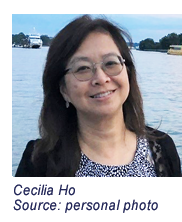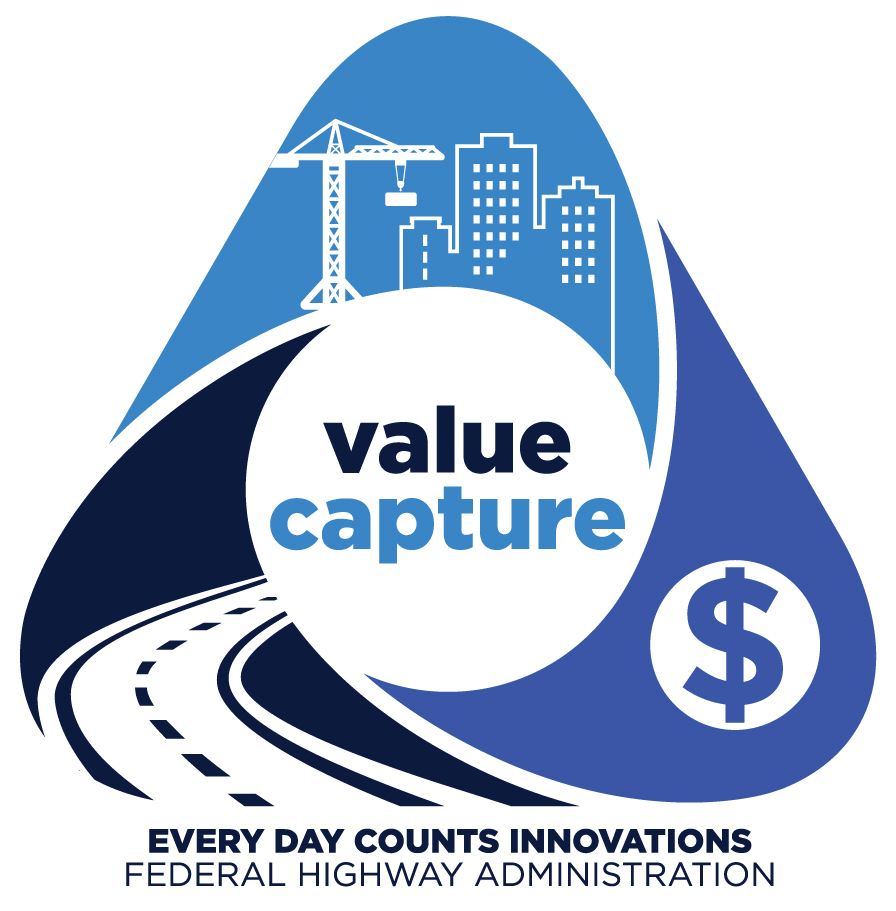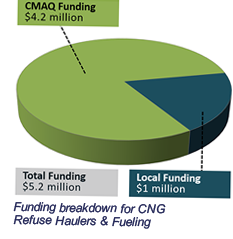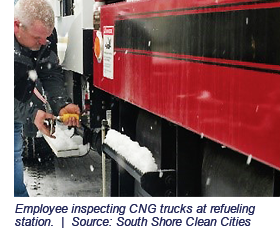Welcome to the Summer 2020 edition of FHWA's Office of Planning, Environment, and Realty's (HEP) research newsletter.
 This quarter the newsletter features three Congestion Mitigation and Air Quality Improvement (CMAQ) projects, the Value Capture Implementation Manual, new Alternative Fuels Corridor Designations, and data modeling in Atlanta, Georgia. This quarter the newsletter features three Congestion Mitigation and Air Quality Improvement (CMAQ) projects, the Value Capture Implementation Manual, new Alternative Fuels Corridor Designations, and data modeling in Atlanta, Georgia.
The Air Quality and Transportation Conformity Team research focuses on the development of analytical tools to support the efficient delivery of highway projects by accelerating the environmental review and permitting process while maintaining a healthy environment by improving air quality, reducing noise, and addressing congestion. The goal of the research program is to provide stakeholders at State departments of transportation (SDOTs) and metropolitan planning organizations (MPOs) with the best tools, data, and examples for efficiently conducting analysis that is required by law to protect the environment. Recent research projects include the development of the CMAQ Emissions Calculator Toolkit (CMAQ Toolkit), CMAQ project spotlights, and the Traffic Noise Model (TNM) Version 3.0. The CMAQ Toolkit provides tools and resources for project sponsors to estimate emissions benefits for projects funded by CMAQ program. The recently completed spotlights on five CMAQ funded projects featured examples that support infrastructure investment while providing air quality improvement and other benefits such as fuel cost savings. You can read about three of these CMAQ spotlight projects below, taking place in Illinois, Indiana, and Georgia. Released in February 2020, TNM 3.0 is the latest update of FHWA's traffic noise model. This updated version includes significant changes to the user interface and improvements to the acoustics algorithms. These enhancements provide users with more flexibility and accuracy during the data entry process, and better visual representations when conducting noise analysis.
The national public health emergency associated with the outbreak of the Coronavirus Disease 2019 (COVID-19) has in some cases altered HEP's research methods such has holding virtual peer exchanges and webinars instead of in person meetings. However, staff are adapting and continue to conduct transportation research that considers the complex relationships among individuals, communities, the economy, and the environment.
We encourage you to explore the resources highlighted in this newsletter, consider contributing to them, and help identify future research needs.
Cecilia Ho
Air Quality & Transportation Conformity Team Lead
Office of Natural Environment
Office of Planning, Environment, and Realty
Value Capture Implementation Manual
 The implementation of value capture techniques needs careful planning to fully realize opportunities to recover some of the value created by public investment. Value capture can be an important source of funding for new transportation projects, but it is almost always used in concert with more traditional sources of funding. The Value Capture Implementation Manual (Manual) details value capture solutions and explains how they can fit project- or context-specific conditions to create overall funding strategies that can accelerate project delivery by providing sustainable and equitable funding streams. The Manual fills knowledge gaps, providing best practices for identifying opportunities for value capture and integrating value capture into priority projects. The implementation of value capture techniques needs careful planning to fully realize opportunities to recover some of the value created by public investment. Value capture can be an important source of funding for new transportation projects, but it is almost always used in concert with more traditional sources of funding. The Value Capture Implementation Manual (Manual) details value capture solutions and explains how they can fit project- or context-specific conditions to create overall funding strategies that can accelerate project delivery by providing sustainable and equitable funding streams. The Manual fills knowledge gaps, providing best practices for identifying opportunities for value capture and integrating value capture into priority projects.
The Manual presents 12 value capture techniques grouped into six categories based on common characteristics. Developer contributions - including impact fees and negotiated exactions - refer to techniques that generate revenues for a project by collecting fees to offset costs imposed by private development. Transportation utility fees generate revenues by levying fees in monthly utility bills that can support local roads projects and operations and maintenance. Special taxes and fees are levied via techniques that include special assessment districts, business improvement districts, sales tax districts, and land value taxes. Tax increment financing captures a portion of new (incremental) taxes generated by projects within a defined district. Joint development refers to techniques in which governments work together with developers to improve the use of land above or near an infrastructure development. Finally, naming rights generate revenues to fund an infrastructure project. The Manual is intended primarily for public sector practitioners and partners across all levels of government. But it may also serve as an educational tool for not-for-profit organizations, stakeholders and community members, and private developers. Workshops on using the Manual were postponed due to the COVID-19 outbreak however, watch for them to be rescheduled in the future.
Georgia, Illinois, and Indiana CMAQ Spotlight Projects
 The CMAQ Program was implemented to support surface transportation projects and other related efforts that contribute air quality improvements and provide congestion relief. CMAQ provides funding to areas in nonattainment or maintenance for ozone, carbon monoxide, and/or particulate matter. Last quarter's newsletter featured CMAQ funded projects in Massachusetts and Washington and this edition's projects in Georgia, Illinois, and Indiana demonstrate how the program is working to reduce emissions and traffic congestion. The CMAQ Program was implemented to support surface transportation projects and other related efforts that contribute air quality improvements and provide congestion relief. CMAQ provides funding to areas in nonattainment or maintenance for ozone, carbon monoxide, and/or particulate matter. Last quarter's newsletter featured CMAQ funded projects in Massachusetts and Washington and this edition's projects in Georgia, Illinois, and Indiana demonstrate how the program is working to reduce emissions and traffic congestion.
Georgia Commute Options is a program managed by the Atlanta Regional Commission (ARC) and funded through the Georgia Department of Transportation. CMAQ is funding $16 million of the project. The Commission has worked with employers, commuters, and schools to reduce the number of single-occupant vehicles on Metro Atlanta's roads-particularly during peak times. Free services are provided to motivate the public to choose clean commute alternatives and to get rewarded in the process. Clean commute options promoted through the program include public transit, telework, carpool, vanpool, biking, and walking. Additional project benefits include: curriculum resources and on-site guidance for giving local schools a transportation makeover, free services for employers to help employees reduce drive-alone commuting, and a Commute Calculator showing the total cost of a commute and potential savings by choosing a clean commute alternative (carpooling or riding transit). The projected emissions reductions per day are VOC -114 kg, NOx - 288 kg, PM2.5 - 2.73 kg.
 The Chicago Metropolitan Agency for Planning sponsored a five-year, two-part project to expand a compressed natural gas facility (CNG) and replacing diesel powered refuse haulers. CMAQ is funding $4.2 million of the project. The first part was the expansion of the Park Forest CNG facility, including design and construction of a new CNG facility in Homewood to provide 30 fill stations plus three filling stations for public access. The project also funded the replacement of 60 diesel powered refuse haulers with 60 CNG refuse vehicles. The vehicles purchased collect refuse and recycling materials, as well as, construction debris in 78 communities in Northeast Illinois. Other benefits include: increased availability of public CNG fueling stations and reduced petroleum consumption. The projected emissions reductions per day are VOC - 0.73 kg, NOx - 34.26 kg, PM2.5 - 0.44 kg. The Chicago Metropolitan Agency for Planning sponsored a five-year, two-part project to expand a compressed natural gas facility (CNG) and replacing diesel powered refuse haulers. CMAQ is funding $4.2 million of the project. The first part was the expansion of the Park Forest CNG facility, including design and construction of a new CNG facility in Homewood to provide 30 fill stations plus three filling stations for public access. The project also funded the replacement of 60 diesel powered refuse haulers with 60 CNG refuse vehicles. The vehicles purchased collect refuse and recycling materials, as well as, construction debris in 78 communities in Northeast Illinois. Other benefits include: increased availability of public CNG fueling stations and reduced petroleum consumption. The projected emissions reductions per day are VOC - 0.73 kg, NOx - 34.26 kg, PM2.5 - 0.44 kg.
The City of Hobart, Indiana in partnership with the South Shore Clean Cities/Northwestern Indiana Regional Planning Commission Green Fleet Program, installed new facilities to safely service its fleet of CNG vehicles, which are fueled on-site at the city's 12-pump CNG fueling station. CMAQ is funding $580,000 of the project. Having both the fueling station and garage as part of the city's public works facility reduces downtime from traveling outside of the city to fuel and the CNG vehicles can now be serviced in-house. City officials chose CNG after receiving recommendations for adopting the alternative fuel as part of an audit conducted through the Green Fleet Program. Hobart officials chose CNG because of its cost effectiveness and emissions savings when compared to diesel. City officials plan to purchase additional CNG vehicles. Additional benefits include: CNG-fueled trucks produce less noise than diesel powered and public access to CNG fueling station. The projected emissions reductions per day are VOC - 0.37 kg, NOx -4.28 kg, PM2.5 - 0.021 kg, CO 1.78 kg.
Alternative Fuel Corridors Round 4 Designations Update and New Convening Summary Report
FHWA recently completed the fourth round of designations for the Alternative Fuels Corridor program. With the designation of these corridors, FHWA is continuing to establish a national network of alternative fueling and charging infrastructure along national highway system corridors. To date, FHWA's Alternative Fuels Corridor Program has included:
- 100 Nominations;
- Designations on segments or entire lengths of 100 Interstate corridors (including Hawaii and Alaska), along with 76 US highways/state roads;
- 49 states (plus the District of Columbia) designated as corridor-ready or corridor-pending for one or more alternative fuel types.
FHWA has also released a summary report of the five regional Alternative Fuel Corridor Convenings held in 2018 and 2019. The report contains information and perspectives from across the country on the installation of alternative fuel infrastructure along highway corridors. Visit the Alternative Fuels Corridor website to learn about the new designations, view the updated corridor maps and information, and the new report. In addition, FHWA is working with three SDOT's and two MPO's to assist with planning for the deployment of alternative vehicle fueling and charging facilities on Interstate corridors. More information on this effort can be found here.
I-85 Atlanta Bridge Collapse Provides Travel Forecasting Data
A Strategic Highway Research Program 2 research project, in partnership with the Atlanta Regional Commission (ARC), has published data suitable for testing, validating, and demonstrating new analysis methodologies, software packages, and visualization approaches for improving travel forecasting as a science. The Atlanta I-85 bridge collapse provided an opportunity to capture travel demand and system performance observations for key time periods before, during, and after the incident. For the project, researchers at ARC used data from the National Performance Measurement Research Dataset database covering the 21-county Atlanta region to represent system performance for the time periods immediately before the collapse, during reconstruction, and after the bridge was reopened. For additional context, observations from the preceding year (2016) and the succeeding year (2018) are included in the data set. This resource will facilitate improving current travel analysis methods as well as new approaches for transport analysis, modeling, and simulation. The data provides a means for researchers to develop and test new methods using quality data at meaningful metropolitan scales. It also provides a means for anyone who wants to evaluate a modeling approach to benchmark scale, speed, and fidelity. Finally, the large dataset provides a rich environment for visualizing regional and corridor scale mobility and system performance in new ways.
New Toolkit Supports Funding of Rural Transportation Projects
The United States Department of Transportation (USDOT) has developed an Applicant Toolkit to provide guidance as part of the Rural Opportunities to Use Transportation for Economic Success (R.O.U.T.E.S.) initiative. This toolkit helps support rural transportation providers to identify and navigate USDOT discretionary grant funding opportunities. The toolkit provides user-friendly information and resources to support rural applicants' understanding of USDOT discretionary grant programs, planning opportunities, programs and funding processes. The R.O.U.T.E.S. Initiative is coordinated across key modal administrations, including the FHWA, the Federal Transit Administration (FTA), the Federal Rail Administration (FRA), and Federal Aviation Administration (FAA). To learn more about this initiative please visit: https://www.transportation.gov/rural.
Webinar of Interest — Virtual Peer Exchange
FHWA's HEP, hosted a virtual peer exchange on virtual public involvement (VPI) tools and strategies to engage traditionally underserved communities on August 17. The online forum featured presentations by Jane Grover, principal at the Chicago Metropolitan Agency for Planning (CMAP) and Jamille Robbins, Public Involvement, Community Studies & Visualization Group Leader at the North Carolina Department of Transportation (NCDOT). Grover discussed strategies used in the development of CMAP's ON TO 2050 plan. Robbins shared strategies used during the environmental review process of the U.S. 70 Improvement Project in James City, NC. Participants engaged with their transportation agency peers to exchange knowledge about using VPI tools in consort with in-person strategies to engage traditionally underserved communities. These communities are comprised of individuals from minority and/or low-income groups who have historically experienced barriers to participation in the transportation decision-making process. They also independently worked on an exercise to apply concepts to a real-world project. Listen to the peer exchange here.
Research Highlights
Environment
E-Scooters Management in Mid-Size Cities in the United States
This research examined several case studies to provide additional observations around micromobility. Interviews were conducted with large, mid-size, and small communities in addition to the FHWA and the National Association of City Transportation Officials to gather perspectives on key emerging issues, challenges and potential guidance. Primary topics explored included; regulation and permitting, safety, and infrastructure design. The final report summarized consistent themes and potential next steps. Staff Contact: Wesley Blount, 202-366-0799
Real Estate
Appraisal for Federal-Aid Highway Programs Training Material Update
This project has redeveloped the 2-day NHI classroom based instructor-led training into two web-based courses of 7-hours each. The first course is a self-paced and student directed distance learning opportunity. The second course is an online instructor-led workshop that offers students some real-world scenarios to resolve. A primary focus will be to explain and illustrate how to incorporate the Uniform Act and 49 CFR part 24 appraisal requirements when appraising real property interests acquired for Federal-aid highway programs. Both courses will also be certified by the International Distance Education Certification Committee (IDECC) of the Association of Real Estate License Law Officials for online education offerings. The IDECC certification will make it easier for students to obtain continuing education credit from their state license agency. This course will be available by January 2021. Staff Contact: Kevin O'Grady, 202-366-2030
State of the Practice — Federal Lands Transfer (FLT) Process
This research updates FHWA's understanding of the current state of the FLT practice (e.g., frequency and extent of use); and has developed information and tools that will enhance the ability of FHWA, Federal Land Management Agencies, and State DOTs to efficiently and effectively complete the FLT process. This research and its tools will be available in Spring of 2021. Staff Contact: Carolyn James, 202-493-0353
Upcoming Events — Due to the Covid-19 pandemic, events may be postponed, cancelled or held virtually

-
September 21 – October 1
North American Bikeshare Association's Together, We Keep Moving Virtual Conference
The NABSA Annual Conference is the leading global venue for bikeshare, shared micromobility, and transportation leaders, practitioners, equipment providers to tackle important issues facing the industry. Join us to learn, network, and chart the future of bikeshare and shared micromobility.
The two-day conference serves as a convening space for shared micromobility professionals and features a variety of topics and speakers. Participants will have access to breakout sessions on topics ranging from open data and privacy to community engagement and marketing.
-
October 26 – 30
AMPO's Virtual Annual Conference
The AMPO Annual Conference is the premier event for MPOs to learn and network. Sessions are taught by experts and offer a combination of presentations and hands-on learning opportunities.
-
January 21 – 22 and 25 – 29, 2021
TRB Annual Meeting — A Virtual Event
The TRB 100th Annual Meeting will be conducted as a virtual event over a series of dates throughout January 2021. Through an interactive virtual event platform, attendees will be able to experience presentation and poster sessions, workshops, exhibits, and committee meetings, and connect with other attendees—just as they have all come to expect from all TRB Annual Meetings. The meeting program will cover all transportation modes, addressing topics of interest to policy makers, administrators, practitioners, researchers, and representatives of government, industry, and academic institutions. The spotlight theme for the 2021 meeting: Launching a New Century of Mobility and Quality of Life.
The Office of Human Environment's Research and Financial Services Team administers research programs and financial support to HEP for research initiatives. The Team provides leadership, coordination, support and implementation of research activities. It also works toward improving outreach, communication and partnerships between Federal, State, and local stakeholders in managing the research programs. For more information, please contact HEP's Primary Research Coordinator: Patricia Cazenas, 202-366-4085.
|